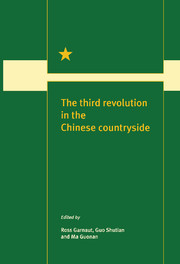Book contents
- Frontmatter
- Contents
- Figures
- Maps
- Tables
- Contributors
- Preface
- 1 The third revolution
- Feeding the people
- Marketing and price reform
- Internationalisation
- 12 The World Trade Organization and agricultural development
- 13 Comparative advantage and the internationalisation of China's agriculture
- 14 A turning point in China's agricultural development
- Regional issues
- Institutional change
- References
- Index
14 - A turning point in China's agricultural development
from Internationalisation
Published online by Cambridge University Press: 04 August 2010
- Frontmatter
- Contents
- Figures
- Maps
- Tables
- Contributors
- Preface
- 1 The third revolution
- Feeding the people
- Marketing and price reform
- Internationalisation
- 12 The World Trade Organization and agricultural development
- 13 Comparative advantage and the internationalisation of China's agriculture
- 14 A turning point in China's agricultural development
- Regional issues
- Institutional change
- References
- Index
Summary
China faces important policy choices
After fifteen years of economic reform, China's agricultural policy is coming to a turning point – the ending of the policies discriminating against agriculture. The government now faces a policy choice between agricultural protection and free trade. This decision will, to a large extent, determine China's future patterns of agricultural production, consumption and trade. It will also affect welfare in China's major trading partners.
Although Chinese economic history and institutions are distinctive, the policy choice is similar to other densely populated countries that have experienced sustained, rapid economic growth. These conditions cause demand for agricultural products to rise more rapidly than economically efficient domestic supply. Britain, the first modern industrial economy, responded to the policy choice first by introducing two protectionist Corn Laws in 1773 and 1815, and then by reversing the policies, abolishing the Corn Laws and opting for free trade in 1846. In East Asia, the tendency so far has been to opt for agricultural protection, favoured in Japan since the 1950s and 1960s and in Taiwan and Korea over the past quarter century. These policies have been costly to domestic welfare and to co-operative relations with international trading partners. Singapore and Hong Kong have benefited from truncated policy choice, with their economic modernisation supported by free access to food at international prices.
- Type
- Chapter
- Information
- The Third Revolution in the Chinese Countryside , pp. 184 - 197Publisher: Cambridge University PressPrint publication year: 1996



